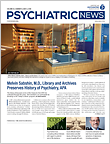I am confident that the discussions we have been having about well-being and burnout at APA at the national and district branch levels and in many of our work settings have opened up a space to talk about our experience of working as psychiatrists.
We function in a rapidly changing system that has squeezed some of the joy and satisfaction out of our work, and the APA Work Group on Physician Well-Being and Burnout is helping to set the conditions for change. The work group was appointed by APA President Anita Everett, M.D., as part of her initiative to address physician burnout and wellness, and as her presidency comes to an end, it’s time to consider what comes next.
This past year, the work group created a
toolkit on physician wellness and burnout that includes an assessment questionnaire. The data collected so far revealed that the majority of the 1,300-plus psychiatrists who took the questionnaire were above the cutoff indicating risk of burnout. The data also showed that women psychiatrists and younger psychiatrists are at greater risk.
While burnout is experienced by individual psychiatrists, it is thought to be largely an effect of the workplace; thus, making changes to the workplace, as well as to workflows, is also critical to greater psychiatrist well-being.
When I Googled “physician burnout,” the links went on for pages and pages. There are many resources and different approaches to addressing physician burnout, and clearly there is no single response for every organization. You can get lost in the swirl of ideas out there. However, the work group wanted to create a toolkit that we thought could support members who want to become a change agent in their workplace (and many of us will have to if we want things to change). Called the Well-Being Ambassadors Toolkit, it includes a PowerPoint slide deck and manual for setting out a roadmap to effect organizational change. Carol Bernstein, M.D., a work group member and former APA president, said, “Since we know that ‘all politics are local,’ we hope that the toolkit will help empower us to successfully confront the daunting challenge of generating culture change in our own backyards.”
The Well-Being Ambassador Toolkit recommends that psychiatrists convene and organize a response within their institutions. This leadership could come from the medical director or chair, or it could come from a member of the staff or a trainee. We have seen all of these scenarios. An organized response involves all of the stakeholders in your setting taking a systematic look at the feelings and needs of psychiatrists and the needs of the organization.
The toolkit provides an easy way for Well-Being Ambassadors to communicate and educate other physicians and administrators about burnout, depression, and physician suicidality to raise awareness and begin this systematic self-study and intervention process.
To be successful, a well-being program starts from the bottom up—it requires involvement from all major groups in the institution as well as buy-in from the leaders. Matt Goldman, M.D., a resident-fellow member of the work group, noted, “The Ambassador’s Toolkit is designed to equip psychiatrists to play a leadership role at their home institutions and really hit the ground running.”
We recommend the following steps to enhance well-being in your workplace and provide detailed guidance about each of them in the PowerPoint slide deck and manual:
Building a wellness team at the institutional level helps find solutions to the specific problems at each institution. Deanna Chaukos, M.D., the wellness lead for the Psychiatry Residency Planning Committee at the University of Toronto and a member of the work group, commented, “Having a breakdown of different well-being categories is helpful as a guide. It’s good for organizing and also good for buy-in.” Each organization’s well-being committee can develop a list of priorities to improve physician well-being. Programming to enhance well-being is like quality improvement—start small and specific, learn from the experience, and build buy-in.
If you are reading this article while you are at APA’s Annual Meeting in New York, you’ll see an impressive array of sessions related to well-being and burnout, including the “Well-Being and Burnout Town Hall 2.0: Adapting and Thriving,” where APA leadership and members of the work group will present their work and engage in an extended discussion with attendees about their experiences, needs, and solutions.
By acknowledging this problem, I hope we can work together to preserve the best in our professional traditions and make the necessary changes to take care of ourselves as well as our patients. I know APA is dedicated to providing continued leadership and support for psychiatrist well-being, and it is up to all of us to advocate for workplace changes that will bring it about. ■
The Wellness Ambassador Toolkit and resources on burnout can be accessed
here.


